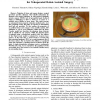Free Online Productivity Tools
i2Speak
i2Symbol
i2OCR
iTex2Img
iWeb2Print
iWeb2Shot
i2Type
iPdf2Split
iPdf2Merge
i2Bopomofo
i2Arabic
i2Style
i2Image
i2PDF
iLatex2Rtf
Sci2ools
ICRA
2009
IEEE
2009
IEEE
Tissue property estimation and graphical display for teleoperated robot-assisted surgery
— Palpation of tissue and organs during a surgical procedure provides clinicians with valuable information for diagnosis and surgical planning. In robot-assisted minimally invasive surgery (RMIS), lack of perceptible haptic feedback makes it challenging to detect a tumor in an organ or a calcified artery hidden in heart tissue. This study presents an automated tissue property estimation method and a realtime graphical overlay that allow an operator to discriminate hard and soft materials. We first analyze the properties of an artificial tissue and compare seven possible models. Selfvalidation as well as cross-validation confirm that the HuntCrossley model best describes the phantom tissue behavior and is suitable for our purpose. While the phantom tissue is palpated using a teleoperated surgical robot, the stiffness of the Hunt-Crossly model is estimated by recursive leastsquares. At the same time, a visual overlay is created using hue-saturation-luminance (HSL) on a semi-transpa...
| Added | 23 May 2010 |
| Updated | 23 May 2010 |
| Type | Conference |
| Year | 2009 |
| Where | ICRA |
| Authors | Tomonori Yamamoto, Balázs Vágvölgyi, Kamini Balaji, Louis L. Whitcomb, Allison M. Okamura |
Comments (0)

